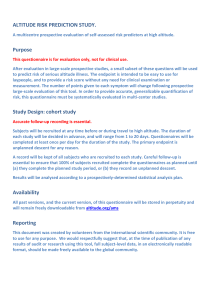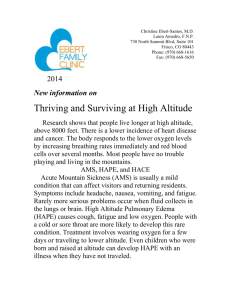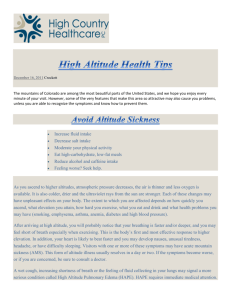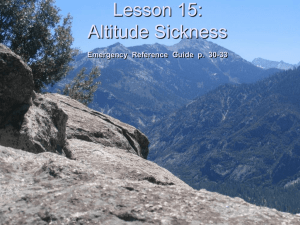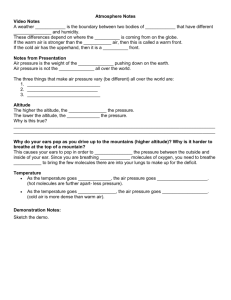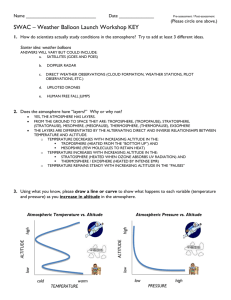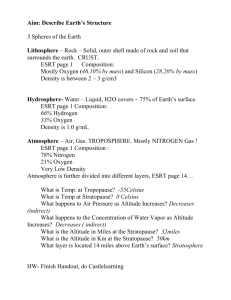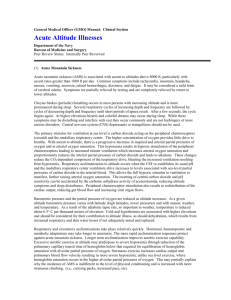risk_prediction_tool_v0.23-AUERBACH-GRISSOM
advertisement
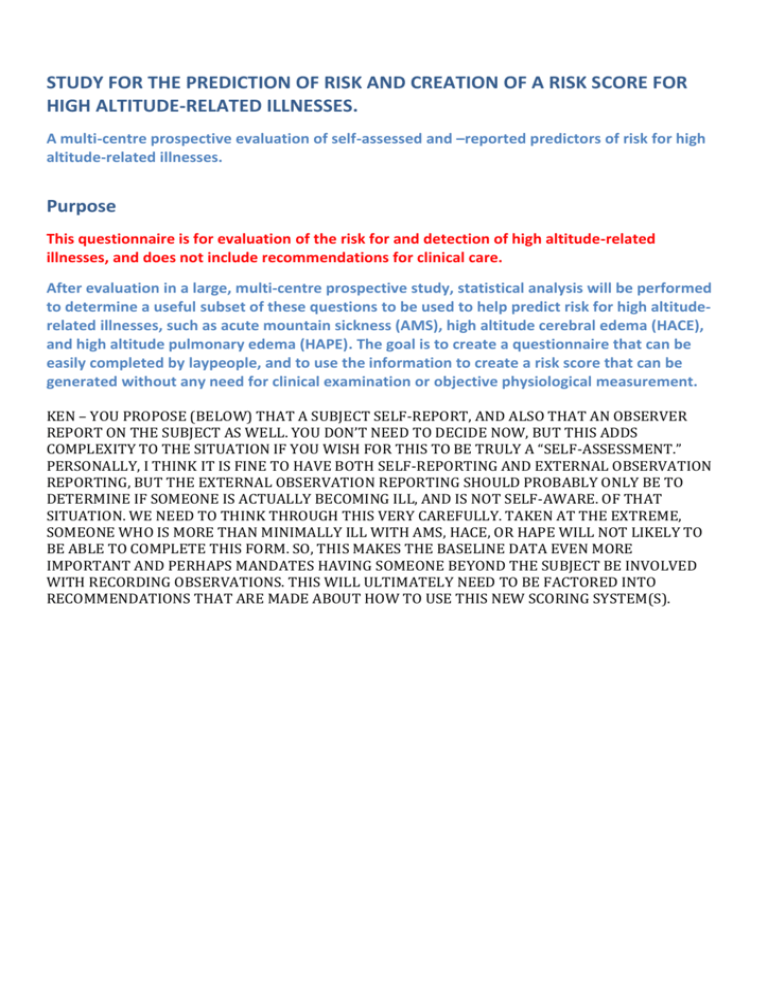
STUDY FOR THE PREDICTION OF RISK AND CREATION OF A RISK SCORE FOR HIGH ALTITUDE-RELATED ILLNESSES. A multi-centre prospective evaluation of self-assessed and –reported predictors of risk for high altitude-related illnesses. Purpose This questionnaire is for evaluation of the risk for and detection of high altitude-related illnesses, and does not include recommendations for clinical care. After evaluation in a large, multi-centre prospective study, statistical analysis will be performed to determine a useful subset of these questions to be used to help predict risk for high altituderelated illnesses, such as acute mountain sickness (AMS), high altitude cerebral edema (HACE), and high altitude pulmonary edema (HAPE). The goal is to create a questionnaire that can be easily completed by laypeople, and to use the information to create a risk score that can be generated without any need for clinical examination or objective physiological measurement. KEN – YOU PROPOSE (BELOW) THAT A SUBJECT SELF-REPORT, AND ALSO THAT AN OBSERVER REPORT ON THE SUBJECT AS WELL. YOU DON’T NEED TO DECIDE NOW, BUT THIS ADDS COMPLEXITY TO THE SITUATION IF YOU WISH FOR THIS TO BE TRULY A “SELF-ASSESSMENT.” PERSONALLY, I THINK IT IS FINE TO HAVE BOTH SELF-REPORTING AND EXTERNAL OBSERVATION REPORTING, BUT THE EXTERNAL OBSERVATION REPORTING SHOULD PROBABLY ONLY BE TO DETERMINE IF SOMEONE IS ACTUALLY BECOMING ILL, AND IS NOT SELF-AWARE. OF THAT SITUATION. WE NEED TO THINK THROUGH THIS VERY CAREFULLY. TAKEN AT THE EXTREME, SOMEONE WHO IS MORE THAN MINIMALLY ILL WITH AMS, HACE, OR HAPE WILL NOT LIKELY TO BE ABLE TO COMPLETE THIS FORM. SO, THIS MAKES THE BASELINE DATA EVEN MORE IMPORTANT AND PERHAPS MANDATES HAVING SOMEONE BEYOND THE SUBJECT BE INVOLVED WITH RECORDING OBSERVATIONS. THIS WILL ULTIMATELY NEED TO BE FACTORED INTO RECOMMENDATIONS THAT ARE MADE ABOUT HOW TO USE THIS NEW SCORING SYSTEM(S). Study Design: cohort study Accurate follow-up recording is essential. Subjects will be recruited at any time before travel to high altitude. KEN – DO WE NEED BASELINE DATA? I WOULD SUGGEST THAT THIS MIGHT BE USEFUL. FOR INSTANCE, IF SOMEONE SUFFERS FROM FREQUENT HEADACHES PRIOR TO ASCENT, WE WOULD LIKE TO KNOW THE NATURE AND FREQUENCY OF THESE HEADACHES. SAME THING FOR ALL THE OTHER SYMPTOMS. The duration of each person’s participation will be the length of their journey to the highest altitude attained and for two days thereafter. Questionnaires will be completed at least once per day for the duration of the study. The primary endpoint is two days after reaching the highest altitude, or unplanned descent for any reason. WE WILL NEED AN EASY WAY TO COMPLETE THE QUESTIONNAIRE BOTH ON PAPER AND ELECTRONICALLY. A record will be kept of all subjects who are recruited into each study. Careful follow-up is essential to ensure that 100% of subjects recruited complete the questionnaires as planned until (a) they complete the planned study period, or (b) they record an unplanned descent. Results will be analysed to achieve the best possible statistical precision. Availability The questionnaire will remain freely downloadable from altitude.org/ams Reporting This document was created by volunteers from the international scientific community. It is free to use for any purpose, under the conditions that (a) the source is attributed to the altitude risk prediction study, and (b) at the time of publication of any results of audit or research using this tool, full subject-level data, in an electronically readable format, should be made freely available to the global community. KEN – I WOULD DELETE THIS ENTIRE SECTION AND ITS REQUIREMENTS. WE SHOULD SIMPLY PUT THE QUESTIONNIARE INTO THE PUBLIC DOMAIN AND LET PEOPLE USE IT IF THEY WISH. WE SHOULD CONTROL THIS STUDY AND THE DATA THAT ENTER INTO IT. WE SHOULD NOT CONTROL WHAT PEOPLE WISH TO DO WITH THE TOOL GOING FORWARD AFTER OUR STUDY. Name/identifier: Altitude-related illnesses risk score (AIRS) v0.23 FOR EVALUATION OF RISK PURPOSES ONLY Please circle one statement in each row that most closely applies to you. Date: Time: KEN – HERE IS WHERE I WOULD ADD COMPLETION OF A BASELINE SURVEY. I WILL ALSO INDICATE FURTHER REFINEMENT OF SOME OF THE QUESTIONS. FOR THE BASELINE HISTORY, I THINK WE SHOULD CONSIDER ADDING: 1. HAVE YOU PREVIOUSLY SUFFERED FROM: a. ACUTE MOUNTAIN SICKNESS b. HIGH ALTITUDE CEREBRAL EDEMA (BRAIN SWELLING) c. ,HIGH ALTITUDE PULMONARY EDEMA (FLUID IN THE LUNGS) 2. HAVE YOU PREVIOUSLY SUFFERED FROM CHRONIC: a. DIZZINESS OR OTHER PROBLEM WITH BALANCE b. BREATHLESSNESS OR OTHER REGULAR BREATHING PROBLEM (SHORTNESS OF BREATH, SUCH AS ASTHMA) c. BLURRED VISION d. SLEEP DISTURBANCE e. COUGH f. HEADACHES i. MIGRAINE ii. TENSION iii. OTHER KEN – HERE ARE ADDITIONAL COMMENTS ABOUT THE FEATURES BELOW. THEY ARE ALL DIRECTED AT ATTEMPTING TO ACHIEVE PRECISION: 1. THERE IS A DIFFERENCE BETWEEN “NONE” AND “MILD.” “NONE” IS THE TOTAL ABSENCE OF A SYMPTOM. SO, YOU SHOULD HAVE 0,1,2, AND 3. YOU MAY EVEN CONSIDER “4” AS “WORST HEADACHE OF MY LIFE.” 2. CONSIDER ADDING LOCATION (FOCALITY) OF THE HEADACHE: FRONTAL, TEMPORAL, OCCIPITAL, GLOBAL. 3. CONSIDER ADDING NATURE OF HEADACHE: THROBBING, CONSTANT, INTERMITTENT 4. NAUSEA AND VOMITING NEED TO BE SEPARATED. IN OTHER WORDS, NAUSEA ALONE WITHOUT VOMITING SHOULD BE A CATEGORY, AND THEN VOMITING SHOULD BE CATEGORIZED AS SINGLE EPISODE OR MULTIPLE EPISODES. 5. CONSIDER ADDING LOSS OF APPETITE AS A SYMPTOM. THIS IS DIFFERENT FROM NAUSEA. 6. SLEEP SEEMS OK, BUT YOU MIGHT WISH TO INCLUDE SOMETHING LIKE “AWAKENED SPONTANEOUSLY DURING SLEEP FEELING SHORT OF BREATH” 7. WITHIN SLEEP, YOU MAY WISH TO ADD SOMETHING LIKE “AWAKENED FEELING RESTED” VERSUS “AWAKENED NOT FEELING RESTED” 8. EXHAUSTED SHOULD BE QUALIFIED FOR THE DEGREE OF EXERTION. IF WE ARE LOOKING FOR FATIGUE AT REST OR WITH MINIMAL EXERTION THAT SEEMS OUT OF THE ORDINARY, LET’S BE SPECIFIC ABOUT IT. 9. COUGH SHOULD BE FURTHER CHARACTERIZED BY NATURE OF COUGH: PRODUCTIVE OF SPUTUM (AND COLOR) VERSUS NON-PRODUCTIVE. WE MAY WISH TO ASK IF THE COUGH IS RELIEVED BY ANYTHING. 10. COMPARISON WITH OTHERS SEEMS LIKE IT SHOULD HAVE SOME CHARACTERISTICS MENTIONED. IT IS VERY VAGUE AS LISTED. CONSIDER SOMETHING LIKE BEING ABLE TO KEEP UP WITH OTHERS. 11. UNSTEADINESS SHOULD BE CHARACTERIZED BY BALANCE, SELF-PERCEIVED GAIT DISTURBANCE, ANY LOSS OF COORDINATION. 12. “NONE OR BREATHLESS WALKING UPHILL” SEEMS LIKE AN ODD COMBINATION. SEPARATE THEM. TRY TO QUANTIFY WHAT YOU MEAN BY BREATHLESSNESS (E.G., PERHAPS RESPIRATORY RATE, AIR HUNGER, ETC.) 13. WE WANT TO KNOW THE AMOUNT OF ASCENT ON A DAY BY DAY BASIS AND CERTAINLY IN THE PRECEDING 24 HOURS PRIOR TO ANY WORSENING IN STATUS. WE WANT TO KNOW THE SLEEP ALTITUDE AS WELL. 14. DO WE WISH TO KNOW THE DRUGS (AND DOSES) TAKEN FOR ANY REASON ON A DAILY BASIS? 15. INFECTION COULD USE SOME CATEGORIES: UPPER RESPIRATORY, SKIN, URINE, GASTROENTERIC, AND SO FORTH. WHY “IN THE LAST 7 DAYS?” I WOULD INCLUDE 3 DAYS PRIOR TO THE BEGINNING OF ASCENT AND THEN ON A DAILY BASIS AFTERWARDS. SELFASSESSMENT 0 1 2 Headache None or mild Moderate headache Severe headache Nausea/ Vomiting None or mild (not feeling sick) Moderate nausea Severe nausea OR have vomited any time in last 24h Sleep Good night’s sleep Moderately disturbed sleep Terrible night’s sleep Not exhausted Slightly exhausted Completely exhausted No cough Any cough Severe cough I feel better than most About average I feel worse than most None Slightly unsteady on feet Very unsteady on feet None or breathless walking uphill Breathless walking slowly on flat surface Breathless at rest Exhaustion Cough Comparison with others Unsteadiness Breathlessness Past history No history of HAPE or HACE, or don’t know I believe I have previously had HAPE or HACE. Speed of ascent in last 3 days Less than 1000m < 3280feet Any infection in last 7 days None Recent infection (eg. cough/cold/ vomiting/ diarrhoea) Female Male Sex More than 1000m > 3280feet More than 2000m > 6560feet SCORE Physical fitness Other illnesses I’m quite unfit About average I’m fitter than most No other illnesses Any other illness for which I currently have a prescription from a doctor (eg. inhalers, tablets) I have another illness that normally limits my ability to exercise Total score: Altitude Sickness Performance Score (ASPS) FOR EVALUATION PURPOSES ONLY Please ask another person who is observing you to complete this questionnaire regarding your performance. KEN – THIS IS A DIFFERENT SURVEY. IT IS AN OBSERVATION OF PERFORMANCE BY ANOTHER PERSON, AND INCLUDES DIFFERENT FEATURES. SO, I THINK IT SHOULD HAVE ANOTHER NAME. EXTERNAL ASSESSMENT 0 1 2 Comparison with others He/she is doing better than most His/her performance is about average He/she is doing worse than most Breathing He/she appears out of He/she appears to be out of breath only when breath when walking on a walking/climbing flat surface uphill He/she appears to be out of breath at rest Unsteadiness He/she is completely steady He/she seems to be a little unsteady when standing or walking He/she seems to be quite unsteady when standing or walking SCORE Total score: Please record your outcomes for today: TICK BOX OUTCOME ASSESSMENT - TODAY CONTINUING AS PLANNED: CHANGING PLANS DUE TO ILLNESS: UNPLANNED DESCENT FOR ANY REASON: IF UNPLANNED DESCENT, PLEASE SPECIFY REASON: SUSPECTED HIGH ALTITUDE CEREBRAL EDEMA (HACE) SUSPECTED HIGH ALTITUDE PULMONARY EDEMA (HAPE) SUSCPECTED ACUTE MOUNTAIN SICKNESS TICK BOX ACCIDENT OR INJURY OTHER REASON (please describe in free text):
